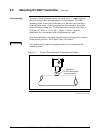
6/08 ST 3000 Release 300 and SFC Model STS103 User’s Manual 39
4.3 Piping ST 3000 Transmitter, Continued
Piping arrangements,
continued
Another piping arrangement uses a block-off valve and a tee connector in
the process piping to the transmitter as shown in Figure 15.
Figure 15 Typical Piping Arrangement for ½” NPT Process Connection
Block-off Valve
1/2" NPT
Connection
Tank Wall
Transmitter location
Table 12 lists the mounting location for the transmitter depending on the
process.
Table 12 Suggested Transmitter Location for Given Process
Process Suggested Location Explanation
Gases Above the gas line The condensate drains away from
the transmitter.
Liquids 1. Below but close to the
elevation of the process
connection.
2. Level with or above the
process connection.
1. This minimizes the static head
effect of the condensate.
2. This requires a siphon to
protect the transmitter from
process steam. The siphon
retains water as a “fill fluid.”
ATTENTION
For liquid or steam, the piping should slope a minimum of 25.4 mm
(1 inch) per 305 mm (1 foot). Slope the piping down towards the
transmitter if the transmitter is below the process connection so the
bubbles may rise back into the piping through the liquid. If the
transmitter is located above the process connection, the piping should rise
vertically above the transmitter; then slope down towards the flowline
with a vent valve at the high point. For gas measurement, use a
condensate leg and drain at the low point (freeze protection may be
required here).
See Appendix B for some suggested freeze protection solutions.


















